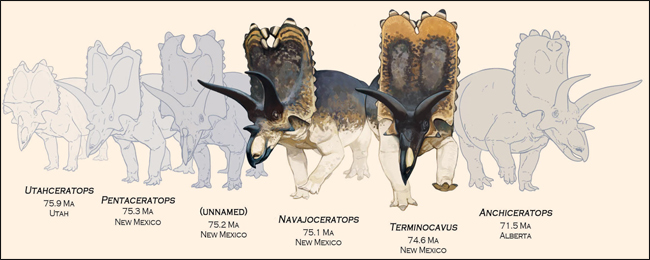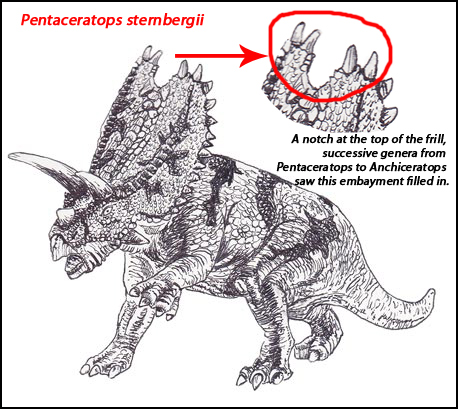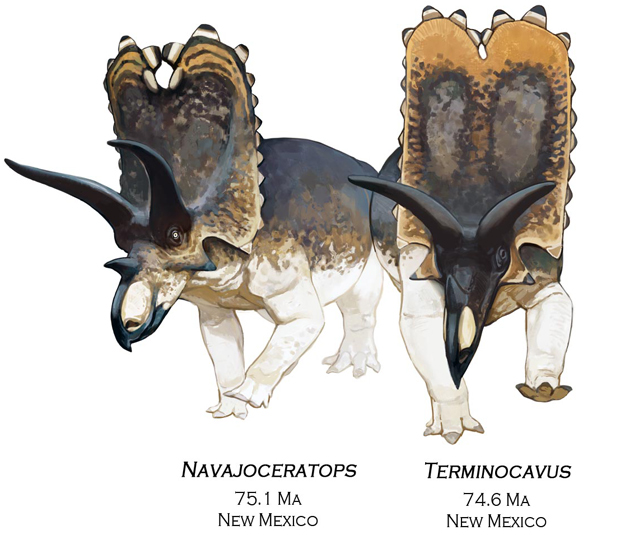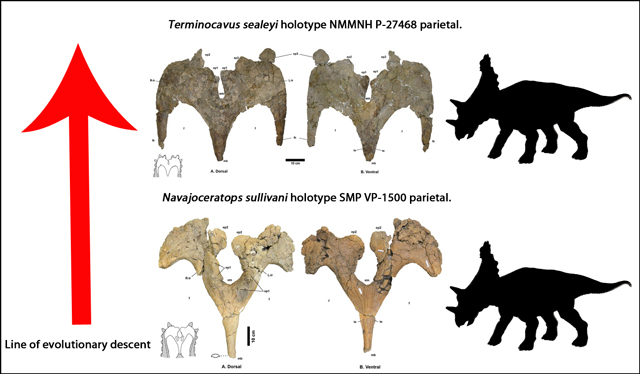Two New Transitional Ceratopsids – Knitting Together Horned Dinosaurs
Two New Transitional Horned Dinosaurs – Navajoceratops sullivani and Terminocavus sealeyi
In the last few days, a scientific paper has been published that proposes a direct evolutionary link between Pentaceratops and the younger chasmosaurine Anchiceratops. The idea that there was a link between Pentaceratops (P. sternbergii) which roamed the New Mexico portion of Laramidia around 75.3 million years ago and Anchiceratops (A. ornatus) which lived much further north (Alberta, Canada), between 72 and 71 million years ago, had been proposed for more than two decades.
This newly published paper names two transitional species – Navajoceratops sullivani and Terminocavus sealeyi, plus describes another new ceratopsid, simply named taxon C. Between them, these new horned dinosaurs help to fill the gap (literally) in chasmosaurine evolution.
Forming Links in an Evolutionary Chain – From Pentaceratops to Anchiceratops

Picture credit: Ville Sinkkonen & Denver Fowler
It’s All About the Embayment
The Ceratopsidae in North America during the Late Cretaceous (Campanian and Maastrichtian faunal stages), diversified and evolved into many different forms. Two great subfamilies emerged the Centrosaurinae and the Chasmosaurinae. The evolutionary links between these two subfamilies and between the genera associated within each subfamily, has generated a great deal of discussion. These dinosaurs are famous for their large skulls with their elaborate, extravagant head shields and horns. Palaeontologists use the differences in the shape, orientation and size of these frills and adornments to determine one species from another.
Although, using the symmetry of the frill of a horned dinosaur to determine a new species can be controversial: Styracosaurus Provides a Head’s up When it Comes to Naming New Ceratopsids.
Navajoceratops sullivani and Terminocavus sealeyi Plus Taxon C
The problems recently highlighted with the discovery of a Styracosaurus with an asymmetrical skull notwithstanding, authors Dr Denver Fowler of the Badlands Dinosaur Museum and Dr Elizabeth Freedman Fowler (Dickinson State University, North Dakota), propose that these three new chasmosaurines, all from the Kirtland Formation of New Mexico, form a morphological succession between Pentaceratops from the older Fruitland Formation of New Mexico and Anchiceratops from the geologically much younger Horseshoe Canyon Formation of Alberta.
The Closing of the Notch in the Frill of Pentaceratops

Picture credit: Everything Dinosaur
Transitional Ceratopsids – The Shape of the Frills Backed by the Stratigraphy
Significantly, the scientists were able to plot a gradual change in the shape of the horned dinosaurs frills, essentially the gradual and successive filling in of a deep notch at the top of the frill (the embayment). Anchiceratops did not have a notch at the top of its frill and the researchers demonstrate that two new partial skull specimens found in rocks intermediate in age between Pentaceratops and Anchiceratops were also intermediate in shape, showing how the notch in the frill became even deeper through time and eventually closed in on itself, explaining the lack of a notch in Anchiceratops.
Writing in the open access journal PeerJ, the researchers note that this step change in frill shape is observed in chasmosaurines that do not overlap stratigraphically. This suggests that over hundreds of thousands of years, species evolved from a direct line of descent. In biology, this is termed anagenesis – the slow and steady evolution of species in a sequence that forms a direct line of evolutionary descent without any obvious branching.
Two New Chasmosaurine Dinosaurs from the Kirtland Formation of New Mexico

Picture credit: Ville Sinkkonen & Denver Fowler
A Five Million Year Evolutionary Line
The two newly named horned dinosaurs Terminocavus sealeyi and Navajoceratops sullivani along with other chasmosaurine specimens from the Farmington and De-na-zin Members of the Kirtland Formation (taxon C), form a sequence of horned dinosaur evolution, stretching over five million years from Utahceratops to Pentaceratops and on to Anchiceratops.
Navajoceratops sullivani is named in honour of the Navajo people who are synonymous with New Mexico. The species name honours the now retired, Dr Robert Sullivan who led the field expedition that resulted in the discovery of the Navajoceratops fossil material. The name translates as “Sullivan’s Navajo horned face”.
Terminocavus sealeyi translates as “Sealey’s closing cavity”, after fossil collector Paul Sealey who found the holotype and due to the fact that the notch in the skull frill is fully closed.
Holotype Parietal Frills of Terminocavus and Navajoceratops

Picture credit: Ville Sinkkonen & Denver Fowler with additional annotation by Everything Dinosaur
An Evolutionary Split
The researchers conclude that fossil material previously assigned to Pentaceratops should be examined once more as it may not represent this taxon. Furthermore, they suggest that there was a splitting event deep in the evolutionary history of the Chasmosaurinae subfamily, after which the Pentaceratops lineage evolved a progressively deepening of the parietal notch in the frill, in contrast to a sister group, the Chasmosaurus lineage which evolved a progressively shallower notch.
The authors propose that encroachment by the Western Interior Seaway around 85-83 million years ago, effectively cut-off dinosaur populations, with a northern and southern population isolated from each other. This permitted two distinct lineages of chasmosaurines to evolve. When the sea retreated around 83 million years ago the two populations were able to mix again.
The Isolation of Dinosaur Populations
The isolation of northern and southern dinosaur populations during the Santonian faunal stage as a result of rising sea levels provides an explanatory mechanism. This mechanism in which high sea level isolated northern and southern dinosaur populations for a period of 1 to 4 million years, lays the foundation for an evolutionary splitting event and provides an explanatory mechanism for the apparent differences between northern and southern dinosaur faunas in the Late Cretaceous of western North America.
Everything Dinosaur acknowledges the assistance of a press release from Dickinson Museum Centre (North Dakota) in the compilation of this article.
The scientific paper: “Transitional evolutionary forms in chasmosaurine ceratopsid dinosaurs: evidence from the Campanian of New Mexico” by Denver W. Fowler and Elizabeth A. Freedman Fowler in PeerJ.
The Everything Dinosaur website: Everything Dinosaur.

